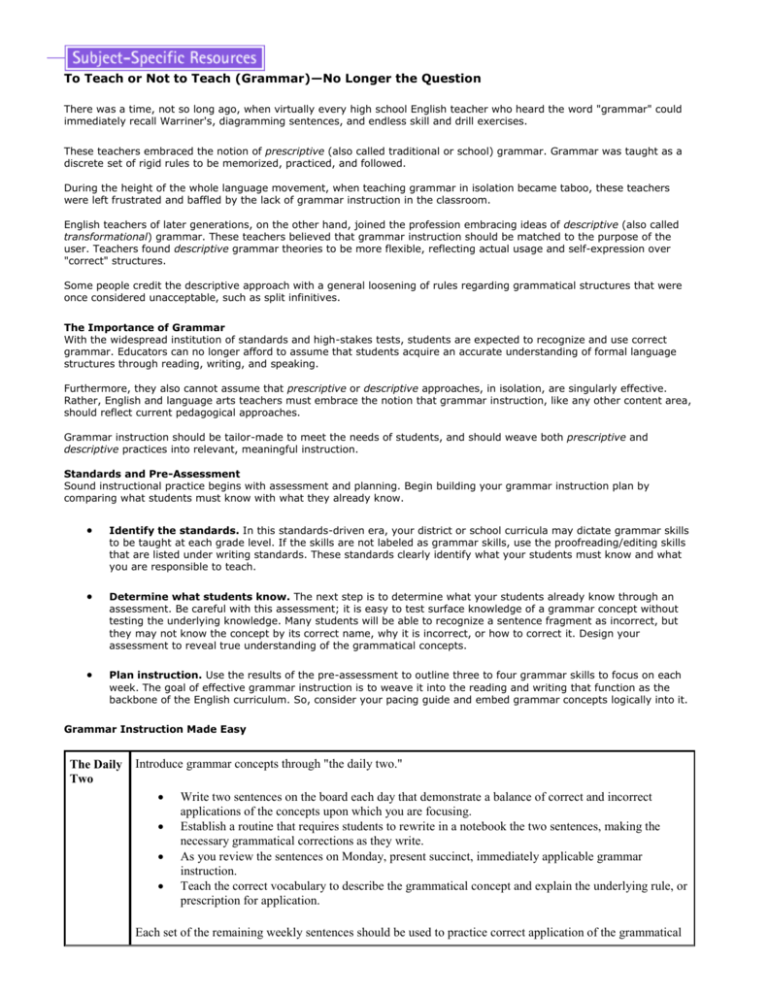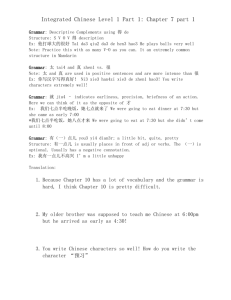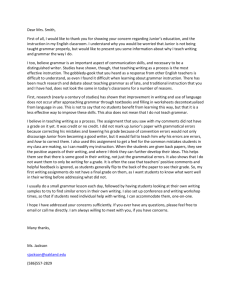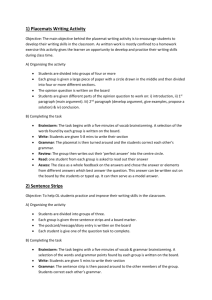
To Teach or Not to Teach (Grammar)—No Longer the Question
There was a time, not so long ago, when virtually every high school English teacher who heard the word "grammar" could
immediately recall Warriner's, diagramming sentences, and endless skill and drill exercises.
These teachers embraced the notion of prescriptive (also called traditional or school) grammar. Grammar was taught as a
discrete set of rigid rules to be memorized, practiced, and followed.
During the height of the whole language movement, when teaching grammar in isolation became taboo, these teachers
were left frustrated and baffled by the lack of grammar instruction in the classroom.
English teachers of later generations, on the other hand, joined the profession embracing ideas of descriptive (also called
transformational) grammar. These teachers believed that grammar instruction should be matched to the purpose of the
user. Teachers found descriptive grammar theories to be more flexible, reflecting actual usage and self-expression over
"correct" structures.
Some people credit the descriptive approach with a general loosening of rules regarding grammatical structures that were
once considered unacceptable, such as split infinitives.
The Importance of Grammar
With the widespread institution of standards and high-stakes tests, students are expected to recognize and use correct
grammar. Educators can no longer afford to assume that students acquire an accurate understanding of formal language
structures through reading, writing, and speaking.
Furthermore, they also cannot assume that prescriptive or descriptive approaches, in isolation, are singularly effective.
Rather, English and language arts teachers must embrace the notion that grammar instruction, like any other content area,
should reflect current pedagogical approaches.
Grammar instruction should be tailor-made to meet the needs of students, and should weave both prescriptive and
descriptive practices into relevant, meaningful instruction.
Standards and Pre-Assessment
Sound instructional practice begins with assessment and planning. Begin building your grammar instruction plan by
comparing what students must know with what they already know.
Identify the standards. In this standards-driven era, your district or school curricula may dictate grammar skills
to be taught at each grade level. If the skills are not labeled as grammar skills, use the proofreading/editing skills
that are listed under writing standards. These standards clearly identify what your students must know and what
you are responsible to teach.
Determine what students know. The next step is to determine what your students already know through an
assessment. Be careful with this assessment; it is easy to test surface knowledge of a grammar concept without
testing the underlying knowledge. Many students will be able to recognize a sentence fragment as incorrect, but
they may not know the concept by its correct name, why it is incorrect, or how to correct it. Design your
assessment to reveal true understanding of the grammatical concepts.
Plan instruction. Use the results of the pre-assessment to outline three to four grammar skills to focus on each
week. The goal of effective grammar instruction is to weave it into the reading and writing that function as the
backbone of the English curriculum. So, consider your pacing guide and embed grammar concepts logically into it.
Grammar Instruction Made Easy
The Daily
Two
Introduce grammar concepts through "the daily two."
Write two sentences on the board each day that demonstrate a balance of correct and incorrect
applications of the concepts upon which you are focusing.
Establish a routine that requires students to rewrite in a notebook the two sentences, making the
necessary grammatical corrections as they write.
As you review the sentences on Monday, present succinct, immediately applicable grammar
instruction.
Teach the correct vocabulary to describe the grammatical concept and explain the underlying rule, or
prescription for application.
Each set of the remaining weekly sentences should be used to practice correct application of the grammatical
concepts for that week, and reinforce concepts from previous weeks. While other minor problems might be
included, such as end marks and beginning capitalization, the emphasis must be to practice and reinforce the
major concepts.
The
Weekly
Five
Continue grammar instruction by expecting students to apply the grammatical concepts you are teaching in
their own writing.
If the concept is subject-verb agreement with an interrupting phrase, assign students to apply that
construct in at least four sentences during an in-class writing assignment.
Collect the papers and carefully select five papers appropriate in topic to be shared with the class.
White out the student names and make enough copies of the paper for each student.
Review with the students the grammar concepts found in the 'daily two' and ask students to
proofread the student papers in search of either correct or incorrect application of those ideas, and
then discuss.
One a Day Finally, weave grammar instruction into reading instruction and study.
Ask students to search for examples of the grammar concept in a piece of literature or nonfiction
being read or studied by the class.
Turn this into a contest by having pairs or small groups skim to locate examples of the concept to
point out to the class.
Ask students to explain how incorrect usage of grammar in the passage might affect the reader.
This article was contributed by Janice Christy, M.Ed., English Department Chair, Louisa County High School, Louisa, Virginia.
Published by Glencoe/McGraw-Hill, a division of the Educational and Professional Publishing Group of The McGraw-Hill Companies,
Inc.,
1221 Avenue of the Americas, New York, New York 10020.
Copyright © 2000-2005 Glencoe/McGraw-Hill. All rights reserved.








